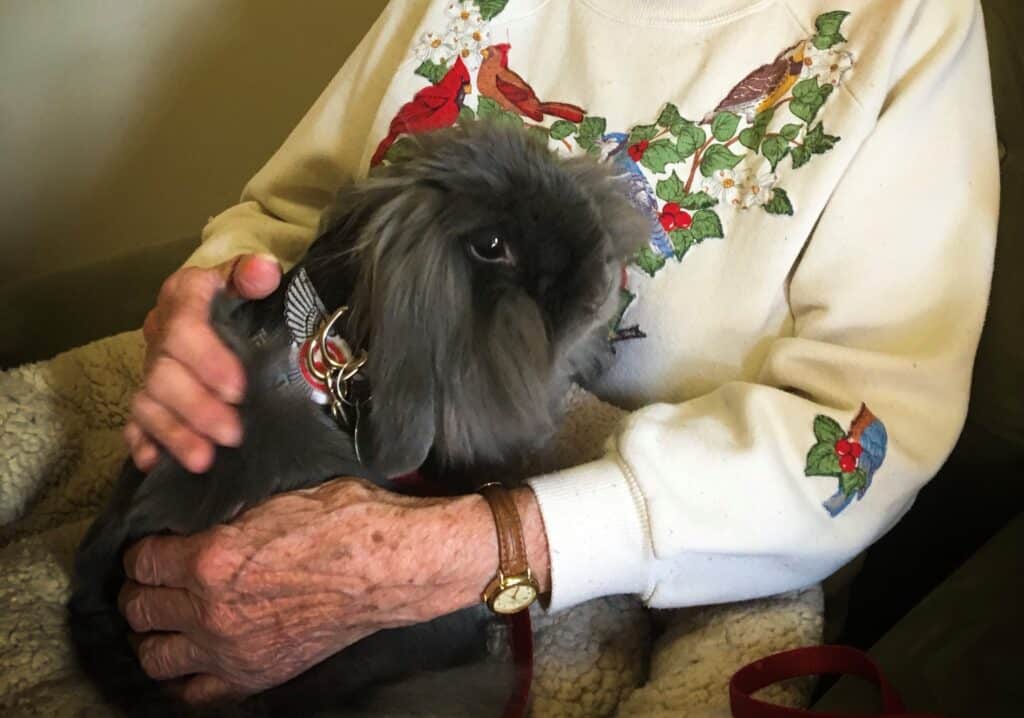




Not all therapy animals are dogs, and prospective handlers who adopt other species may need specialized information on how to prepare their pets for therapy animal work. For this guest post we welcome Kristin Woodbury with House Rabbit Society and a previous therapy rabbit handler, who offers advice on rabbit socialization. This post is part of a continuing series about preparing to become a therapy animal team.
Getting a pet rabbit brings bundles of joy. However, like humans, all rabbits have their own unique and lovable personalities, so naturally some bunnies are more social than others. Some rabbits are even antisocial by nature, so it’s going to take a lot of care, love, and nurturing to socialize your rabbit to enjoy cuddles. Even if your pet has an outgoing personality, these five socializing tips will help bring your floppy-eared pal out of their shell.
One of the main reasons for antisocial tendencies in rabbits is lack of trust or lack of feeling comfortable in their surroundings. This should not come as a surprise, because rabbits are herbivores and they are prey for numerous carnivores in the wild. That’s why rabbits are mistrustful of other animals by nature, humans included.
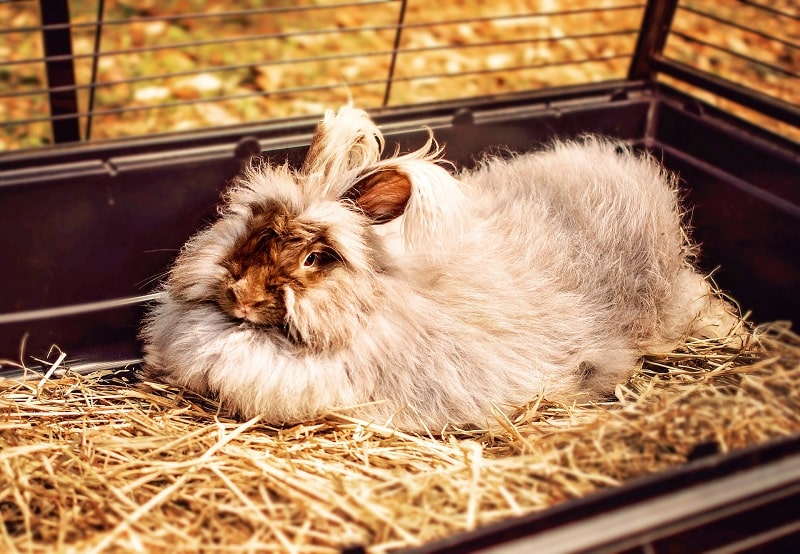
You can help your rabbit open up by creating a comfortable and safe environment for them to thrive in. The fact that they live in an enclosed space shouldn’t have a profound impact on their social skills, but noise can make them stop reacting to social interaction. Their enclosure should be kept in a quiet location in your house, away from scary loud bangs, car horns, or noisy kitchen appliance sounds.
Of course, this doesn’t mean that your rabbit should be completely isolated from people. Ideally, they should live in a quiet place with a view of humans or your typical family day-to-day activities, so they can get used to your presence and realize that you’re not a threat.
Top tip: Giving your rabbit a few pats a day (three to five) should help introduce them to your touch and smell and help them understand you’re not a danger to their existence. You can do this when you take them food so they have a positive association with you.
If you want a person to like you, you’d probably buy them lunch, or at the very least, a bar of chocolate. Well, a rabbit’s love can be won over in the same manner, by feeding them the food they like the most. A typical rabbit should never be left without enough hay, bromegrass, or Timothy grass that they can nibble on. Hay is rich in fiber that is essential for your rabbit’s gastrointestinal health.
Furthermore, you should feed your rabbit pellets on a daily basis. The younger the bunny, the larger the percentage of pellets in their diet. Ideally, the pellets should contain around 17% protein and 18% fiber. The amount of pellets you should feed your bunny daily is based on their weight. PetCoach explains:
A standard guideline is 1/4 cup of pellets per 6 lbs. of body weight per day. Several servings of vegetables are required (2 cups per 6 pounds of body weight daily). Make sure to choose dark, leafy greens, and feed at least three different kinds daily.
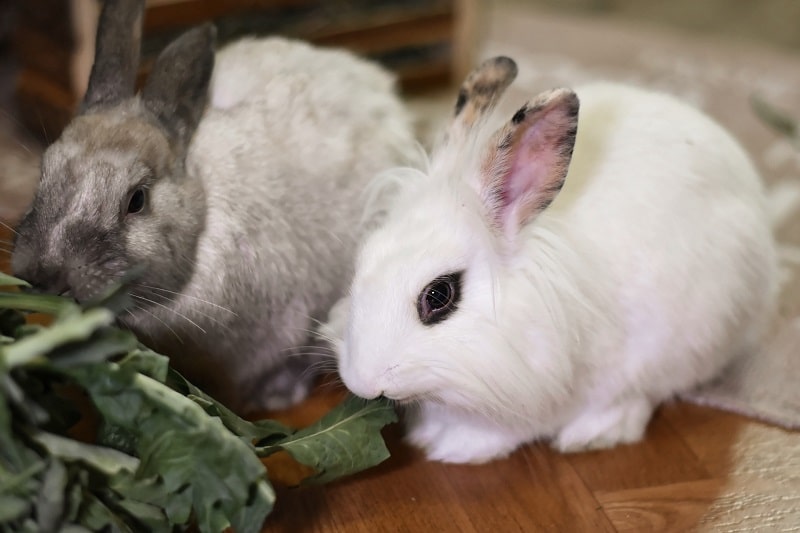
As PetCoach touched on, aside from hay and pellets, a rabbit’s diet should include a variety of leafy greens. Popular fiction got it right that rabbits like carrots and lettuce, but they also enjoy eating a wide variety of vegetables, such as parsley, kale, radish, basil, and other leafy and root vegetables.
You can let them have a treat once per day in the form of some apple slices or a few raisins.
Finally, your rabbit should have constant access to fresh water in a heavy bowl or a crock.
When your rabbit is full and happy, it’s time to give them a few pats and see if you can gain their trust by stimulating their playfulness.
As well as providing your rabbit with a safe and quiet environment to live in, you should play with your bunny as often as possible. Playtime is a great way to socialize your rabbit and give them some exercise, too. Ensuring your pet rabbit has enough room to play is especially important if the animal is kept in a crate or a cage where mobility is limited.
 The best possible place for playing with your rabbit is outside in their natural habitat. Get a sturdy rabbit carrier to transport the animal outside. Any outside space for your rabbit should be fenced. To prevent your furry friend from escaping, make sure there are no holes in the fence or burrow holes the animal could use as an escape tunnel.
The best possible place for playing with your rabbit is outside in their natural habitat. Get a sturdy rabbit carrier to transport the animal outside. Any outside space for your rabbit should be fenced. To prevent your furry friend from escaping, make sure there are no holes in the fence or burrow holes the animal could use as an escape tunnel.
If you decide to play with the rabbit inside the house, remove all electrical cords—they could get seriously hurt chewing on those.
You can find out a great deal of information about your rabbit’s personality by observing its reactions to human touch.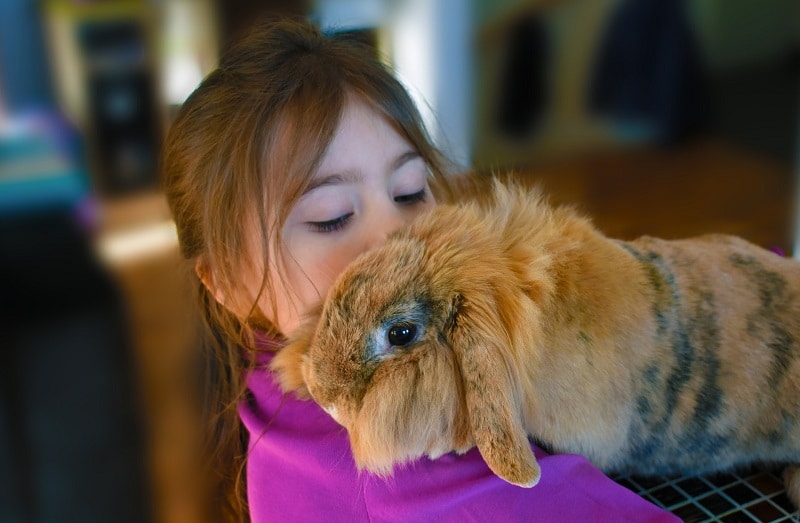
Another factor in a rabbit’s overall happiness is their living conditions, which includes temperature. A comfortable temperature for most rabbit species ranges from 15.5 to 21 degrees Celsius (60 to 70 degrees Fahrenheit).
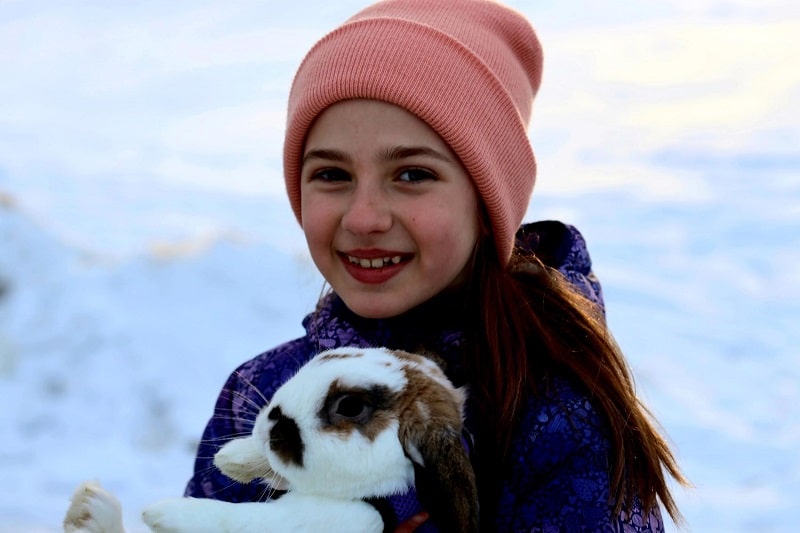
Once you ensure your rabbit’s room temperature is optimal, you should try to keep it stable because rabbits don’t handle large fluctuations in air temperatures well. After all, that’s why they live in dens that are insulated.
In fact, if the temperature is outside the aforementioned range, you are risking your rabbit’s health. It’s also important to note that your rabbit’s enclosure should not be placed in direct sunlight; even weak shade helps the animal regulate its environmental temperature and prevents overheating.
If you like your pet rabbit, have no doubt your rabbit will like you back, regardless of how antisocial they may appear at first. Gain the rabbit’s trust through safety, food, comfort, and playtime, and you’ll soon start to be rewarded with licks and cuddles.
Do you think you and your rabbit might be a good fit for our Therapy Animal Program? Learn more about the process, including how to access our resources especially for rabbit teams.